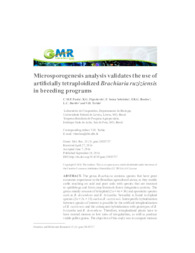Microsporogenesis analysis validates the use of artificially tetraploidized Brachiaria ruziziensis in breeding programs.
Microsporogenesis analysis validates the use of artificially tetraploidized Brachiaria ruziziensis in breeding programs.
Autoria: PAULA, C. M. P.; FIGUEIREDO, K. G.; SOUZA SOBRINHO, F. de; BENITES, F. R. G.; DAVIDE, L. C.; TECHIO, V. H.
Resumo: The genus Brachiaria contains species that have great economic importance in the Brazilian agricultural sector, as they enable cattle ranching on acid and poor soils with species that are resistant to spittlebugs and form crop-livestock-forest integration systems. The genus mainly consists of tetraploid (2n = 4x = 36) and apomictic species such as B. decumbens and B. brizantha. Sexuality is found in diploid species (2n = 2x = 18) such as B. ruziziensis. Interspecific hybridization between species of interest is possible by the artificial tetraploidization of B. ruziziensis and the subsequent hybridization with genotypes of B. brizantha and B. decumbens. Therefore, tetraploidized plants have to have normal meiosis or low rates of irregularities, as well as produce viable pollen grains. The objective of this study was to compare meiosis and pollen grain viability and morphology in artificially tetraploidized B. ruziziensis with that of descendants generated from crossing and selfing. The frequency of meiotic abnormalities ranged from 4.43 to 11%, and pollen viability ranged from 61 to 85%. Abnormalities were detected from prophase I to the tetrad stage with a variable frequency between the genotypes. The meiotic behavior of the artificially tetraploidized plants was little affected, and the pollen viability of the genotypes was high. Regarding pollen grain ultrastructure, there were no variations or morphological changes in the different genotypes. The genotypes have meiotic stability and high pollen viability, and can be incorporated into Brachiaria breeding programs.
Ano de publicação: 2016
Tipo de publicação: Artigo de periódico
Unidade: Embrapa Gado de Leite
Palavras-chave: Pollen grain
Observações
1 - Por padrão são exibidas publicações dos últimos 20 anos. Para encontrar publicações mais antigas, configure o filtro ano de publicação, colocando o ano a partir do qual você deseja encontrar publicações. O filtro está na coluna da esquerda na busca acima.
2 - Para ler algumas publicações da Embrapa (apenas as que estão em formato ePub), é necessário ter, no celular ou computador, um desses softwares gratuitos. Sistemas Android: Google Play Livros; IOS: iBooks; Windows e Linux: software Calibre.
Acesse outras publicações
Acesse a Base de Dados da Pesquisa Agropecuária (BDPA) para consultar o acervo completo das bibliotecas da Embrapa.

